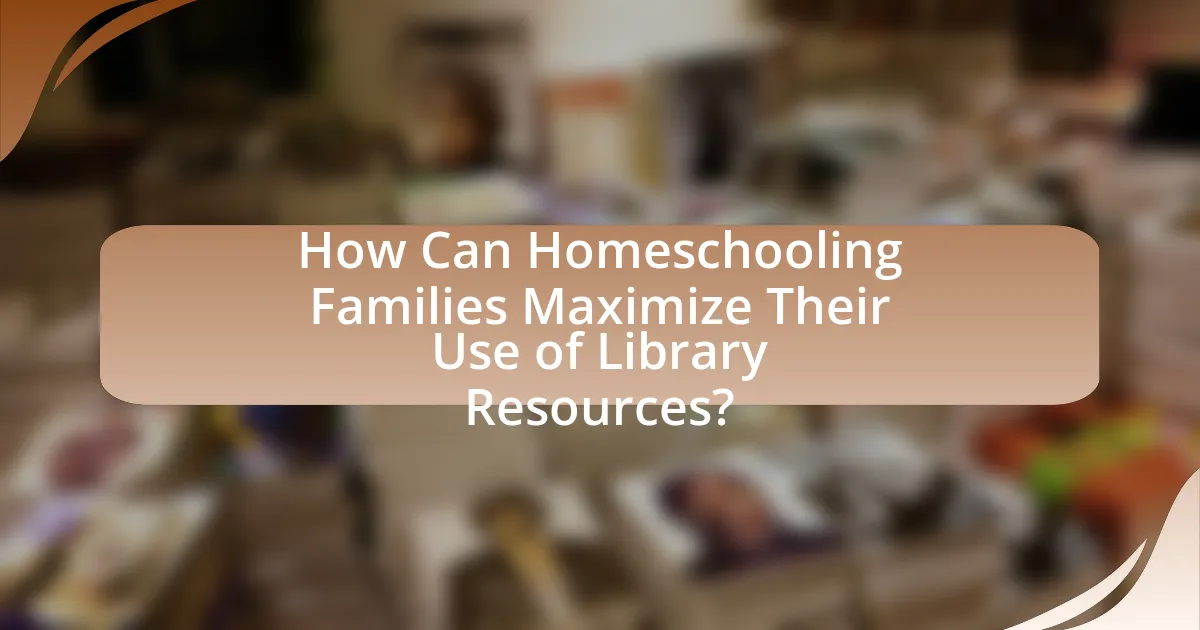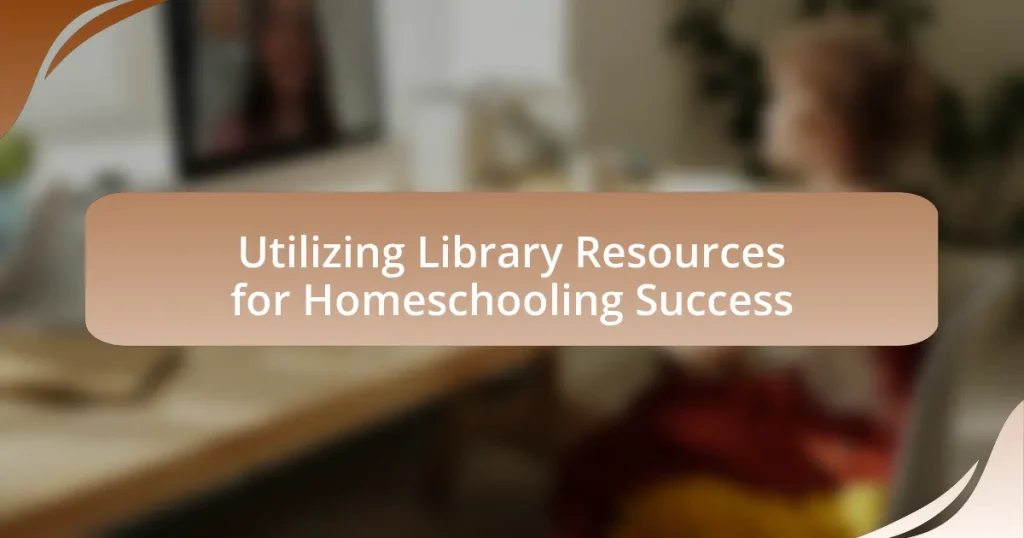Library resources play a vital role in supporting homeschooling by providing access to a wide range of educational materials, including books, online databases, and community programs. These resources cater to diverse learning styles and subjects, enhancing the educational experience for homeschooling families. Libraries offer free access to workshops, tutoring services, and digital content, which can significantly reduce educational costs and promote independent learning. By utilizing library resources effectively, families can enrich their curriculum, foster critical thinking, and improve academic performance, making libraries essential partners in the homeschooling journey.

What are Library Resources and Their Importance in Homeschooling?
Library resources encompass a variety of materials and services provided by libraries, including books, e-books, databases, educational programs, and access to technology. These resources are crucial in homeschooling as they offer diverse learning materials that cater to different subjects and learning styles, enhancing the educational experience. For instance, according to the American Library Association, libraries provide access to over 100 million books and numerous online databases, which can significantly support a homeschool curriculum by offering reliable information and varied perspectives. Additionally, libraries often host workshops and events that foster community engagement and provide socialization opportunities for homeschooled children, further enriching their educational journey.
How can library resources enhance the homeschooling experience?
Library resources enhance the homeschooling experience by providing access to a wide range of educational materials, including books, online databases, and multimedia resources. These materials support diverse learning styles and subjects, allowing homeschooling families to tailor their curriculum effectively. For instance, public libraries often offer free access to educational programs, workshops, and tutoring services, which can supplement the homeschooling curriculum. Additionally, libraries frequently provide access to digital resources, such as e-books and online courses, which can be particularly beneficial for remote learning. Studies show that children who utilize library resources demonstrate improved literacy skills and academic performance, reinforcing the value of libraries in the educational process.
What types of library resources are available for homeschooling families?
Library resources available for homeschooling families include books, online databases, educational programs, and community events. Libraries typically offer a wide range of books covering various subjects and grade levels, which can support the diverse curriculum needs of homeschooling families. Additionally, many libraries provide access to online databases that contain academic journals, e-books, and multimedia resources, enhancing research capabilities. Educational programs, such as workshops and classes tailored for children, are often organized by libraries to foster learning and social interaction. Furthermore, community events hosted by libraries can provide networking opportunities and support for homeschooling families.
How do library resources support different learning styles?
Library resources support different learning styles by providing a diverse range of materials and formats that cater to visual, auditory, and kinesthetic learners. For instance, visual learners benefit from books, charts, and videos available in libraries, while auditory learners can access audiobooks and lectures. Kinesthetic learners find hands-on resources such as interactive exhibits and workshops. Research indicates that varied instructional materials enhance engagement and retention, as evidenced by studies showing that students exposed to multiple formats perform better academically. Thus, libraries play a crucial role in accommodating diverse learning preferences, facilitating effective homeschooling experiences.
Why should homeschooling families utilize library resources?
Homeschooling families should utilize library resources because they provide access to a vast array of educational materials and programs that enhance learning. Libraries offer books, digital resources, and educational workshops that support diverse curricula and learning styles. For instance, according to the American Library Association, 90% of libraries provide free access to educational programs, which can significantly enrich the homeschooling experience. Additionally, libraries often have knowledgeable staff who can assist families in finding specific resources tailored to their educational needs, making them invaluable partners in the homeschooling journey.
What are the cost benefits of using library resources for homeschooling?
Using library resources for homeschooling significantly reduces educational costs. Libraries provide free access to a wide range of materials, including books, e-books, audiobooks, and educational databases, which can otherwise be expensive to purchase. For instance, the average cost of textbooks can exceed $1,000 per year for a single student, while library resources eliminate this expense. Additionally, many libraries offer free programs, workshops, and tutoring services, further enhancing the educational experience without additional financial burden. This access to diverse learning materials and community resources allows homeschooling families to save money while providing a comprehensive education.
How do library resources promote independent learning?
Library resources promote independent learning by providing access to a diverse range of materials, including books, journals, and digital content, which support self-directed study. These resources enable learners to explore topics at their own pace, fostering critical thinking and research skills. For instance, studies show that students who utilize library resources demonstrate improved academic performance and greater engagement in their learning processes. Access to databases and reference materials allows individuals to conduct thorough research, enhancing their ability to learn independently and effectively.

What Specific Library Resources Can Be Utilized for Homeschooling?
Specific library resources that can be utilized for homeschooling include books, online databases, educational DVDs, and access to tutoring programs. Libraries often provide a vast collection of textbooks and reference materials that cover various subjects, which can be essential for a comprehensive homeschooling curriculum. Online databases, such as JSTOR or EBSCOhost, offer access to academic journals and articles that can enhance research capabilities. Additionally, many libraries have educational DVDs that cover topics in science, history, and literature, providing visual learning aids. Furthermore, libraries frequently host tutoring programs or workshops that can support homeschooling families by offering guidance and resources tailored to specific educational needs.
What types of books and materials are available at libraries?
Libraries offer a diverse range of books and materials, including fiction, non-fiction, reference books, periodicals, e-books, audiobooks, and multimedia resources. Fiction books encompass various genres such as mystery, romance, and science fiction, while non-fiction includes subjects like history, science, and self-help. Reference materials consist of encyclopedias, dictionaries, and atlases, which provide factual information. Periodicals include magazines and newspapers that cover current events and specialized topics. Additionally, libraries often provide access to digital resources, including e-books and audiobooks, which can be borrowed online. Multimedia resources may include DVDs and educational software, enhancing the learning experience. This variety supports diverse educational needs, making libraries essential for homeschooling success.
How can families find age-appropriate books for their children?
Families can find age-appropriate books for their children by utilizing library resources, including age-specific reading lists and librarian recommendations. Libraries often provide curated collections categorized by age and reading level, which can guide families in selecting suitable books. Additionally, many libraries offer online databases and catalogs that allow families to search for books based on age, genre, and reading level, ensuring that the selections align with the child’s developmental stage.
What are the benefits of using reference materials from libraries?
Using reference materials from libraries provides access to reliable and authoritative information, which is essential for effective learning. Libraries offer a vast collection of reference materials, including encyclopedias, dictionaries, and academic journals, that are curated for accuracy and credibility. This access enhances the quality of research and supports the development of critical thinking skills. Furthermore, utilizing these resources can save time and effort, as they are organized and readily available for users, allowing for efficient information retrieval. Studies show that students who engage with library resources tend to perform better academically, highlighting the importance of these materials in educational success.
How can digital resources from libraries aid homeschooling?
Digital resources from libraries can significantly aid homeschooling by providing access to a wide range of educational materials, including e-books, online databases, and instructional videos. These resources enhance the learning experience by offering diverse content that caters to different learning styles and subjects. For instance, many libraries offer platforms like OverDrive or Hoopla, which allow users to borrow e-books and audiobooks, thus expanding the curriculum options available to homeschooling families. Additionally, online databases such as JSTOR or ProQuest provide access to academic journals and articles, supporting research and deeper understanding of various topics. Furthermore, many libraries offer free access to online courses and tutorials, which can supplement traditional homeschooling methods and provide structured learning paths.
What online databases and e-books are accessible through libraries?
Libraries provide access to a variety of online databases and e-books, including academic resources like JSTOR, ProQuest, and EBSCOhost, as well as e-book platforms such as OverDrive and Hoopla. These databases offer a wealth of scholarly articles, journals, and e-books that support research and learning. For instance, JSTOR contains over 12 million academic journal articles, books, and primary sources, while OverDrive allows users to borrow e-books and audiobooks from a vast collection. Access to these resources typically requires a library membership, which validates the user’s eligibility to utilize these digital offerings.
How can families effectively use online resources for research projects?
Families can effectively use online resources for research projects by utilizing academic databases, educational websites, and digital libraries. Academic databases like JSTOR and Google Scholar provide access to peer-reviewed articles and research papers, ensuring credible information. Educational websites such as Khan Academy and National Geographic offer structured content that can enhance understanding of various subjects. Digital libraries, including Project Gutenberg and the Internet Archive, provide free access to a vast array of books and historical documents, supporting diverse research topics. By combining these resources, families can gather comprehensive and reliable information for their projects.

How Can Homeschooling Families Maximize Their Use of Library Resources?
Homeschooling families can maximize their use of library resources by actively engaging with library programs, utilizing online databases, and collaborating with librarians for tailored educational support. Libraries often offer workshops, reading programs, and educational events specifically designed for families, which can enhance learning experiences. Additionally, many libraries provide access to digital resources such as e-books, audiobooks, and academic databases, which can supplement homeschooling curricula. Collaborating with librarians allows families to receive personalized recommendations and access specialized materials that align with their educational goals. This approach not only enriches the homeschooling experience but also fosters a strong relationship with the local library, ensuring ongoing support and resource availability.
What strategies can families employ to make the most of library visits?
Families can employ several strategies to maximize their library visits, including planning ahead, utilizing library programs, and engaging with library staff. Planning ahead involves creating a list of specific books or resources needed for homeschooling, which can save time and ensure that families focus on relevant materials. Utilizing library programs, such as story hours or educational workshops, can enhance learning experiences and provide additional resources tailored to children’s interests. Engaging with library staff allows families to gain insights into available resources and recommendations that align with their educational goals. These strategies collectively enhance the effectiveness of library visits for homeschooling success.
How can families create a library schedule that fits their homeschooling routine?
Families can create a library schedule that fits their homeschooling routine by assessing their educational needs and aligning library visits with their curriculum. First, families should identify specific subjects or topics that require additional resources, then determine the frequency of library visits that accommodates their homeschooling schedule, such as weekly or bi-weekly trips.
Next, families can utilize library programs, such as story times or workshops, to enhance learning while ensuring these events fit within their planned schedule. Additionally, families should consider the library’s operating hours and plan visits during less busy times to maximize resource availability and engagement.
By integrating library visits into their homeschooling routine, families can effectively utilize library resources to support their educational goals.
What tips can help families engage with librarians for support?
Families can engage with librarians for support by actively participating in library programs and utilizing available resources. Attending workshops, storytimes, and educational events allows families to build relationships with librarians, who can provide tailored recommendations and support for homeschooling needs. Additionally, families should communicate their specific educational goals and interests to librarians, enabling them to suggest relevant materials and resources. Research indicates that libraries often offer specialized services for homeschooling families, including access to databases, curriculum guides, and one-on-one consultations, which can enhance the homeschooling experience.
What are some common challenges in utilizing library resources for homeschooling?
Common challenges in utilizing library resources for homeschooling include limited access to materials, varying availability of educational resources, and insufficient support from library staff. Limited access can occur due to geographical constraints or library policies that restrict borrowing for non-traditional students. Varying availability means that not all libraries have the same range of educational materials, which can hinder curriculum development. Insufficient support from library staff may arise from a lack of training in homeschooling needs, making it difficult for parents to receive tailored assistance. These challenges can significantly impact the effectiveness of library resources in a homeschooling environment.
How can families overcome barriers to accessing library resources?
Families can overcome barriers to accessing library resources by utilizing online catalogs and digital resources, which provide remote access to a wide range of materials. Many libraries offer e-books, audiobooks, and educational databases that can be accessed from home, thus eliminating the need for physical visits. Additionally, families can participate in library programs and workshops designed to educate them about available resources and how to use them effectively. According to the American Library Association, 90% of libraries provide online resources, making it easier for families to access information without geographical constraints.
What solutions exist for families facing limited library access?
Families facing limited library access can utilize online library services, community book exchanges, and local educational resources. Online library services, such as digital lending platforms like OverDrive and Libby, provide access to e-books and audiobooks, allowing families to borrow materials remotely. Community book exchanges, often found in neighborhoods or through social media groups, enable families to share and acquire books without needing a physical library. Additionally, local educational resources, including museums and educational organizations, frequently offer free or low-cost access to learning materials and programs that can supplement homeschooling efforts. These solutions collectively enhance educational opportunities for families with restricted library access.
What best practices should families follow when using library resources for homeschooling?
Families should prioritize organization and planning when using library resources for homeschooling. Establishing a structured schedule for library visits and resource utilization ensures that families maximize their time and access to materials. Additionally, families should familiarize themselves with the library’s catalog and online databases to efficiently locate relevant books, educational programs, and digital resources. Engaging with librarians can provide tailored recommendations and insights into available resources that align with the family’s curriculum. Furthermore, families should take advantage of library workshops and events that promote learning and community engagement, enhancing the homeschooling experience. These practices are supported by studies indicating that structured resource use significantly improves educational outcomes in homeschooling environments.
How can families track and organize library materials effectively?
Families can track and organize library materials effectively by implementing a systematic approach that includes using digital tools, maintaining a physical inventory, and establishing a check-out system. Digital tools such as library management apps or spreadsheets allow families to catalog materials, track due dates, and monitor the status of borrowed items. Maintaining a physical inventory involves creating a designated space for library materials, labeling items, and regularly updating the list of materials on hand. Establishing a check-out system, where family members log borrowed items and their return dates, ensures accountability and helps prevent overdue materials. This organized method enhances the efficiency of utilizing library resources for homeschooling success.
What are some tips for integrating library resources into lesson plans?
Integrating library resources into lesson plans can enhance educational experiences by providing diverse materials and support. First, educators should collaborate with librarians to identify relevant resources that align with curriculum goals, ensuring that the materials are appropriate for the lesson objectives. For example, using databases for research projects can provide students with access to peer-reviewed articles and primary sources, which enrich their understanding of the subject matter.
Additionally, incorporating library activities, such as guided research sessions or workshops on information literacy, can help students develop essential skills in navigating and evaluating sources. Research indicates that students who engage with library resources demonstrate improved critical thinking and research skills (Association of College and Research Libraries, 2016).
Finally, utilizing online library catalogs and digital resources allows for easy access to e-books and multimedia content, which can be integrated into lesson plans to cater to various learning styles. By leveraging these strategies, educators can effectively enhance their lesson plans with library resources, fostering a more engaging and informative learning environment.










